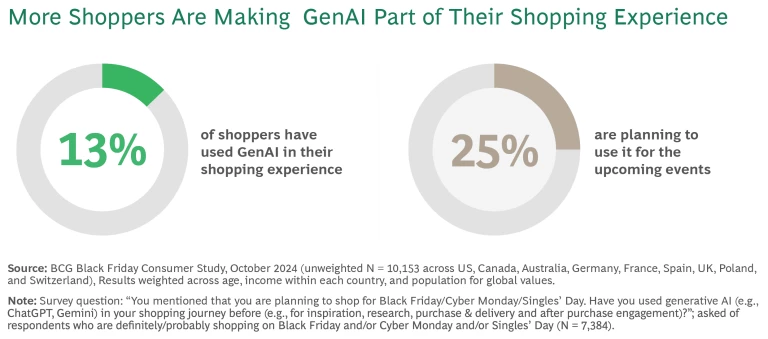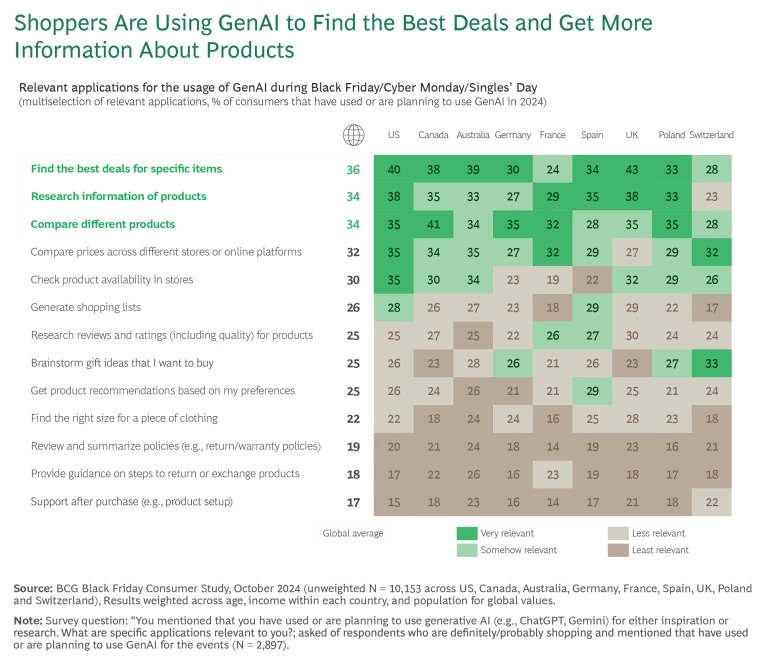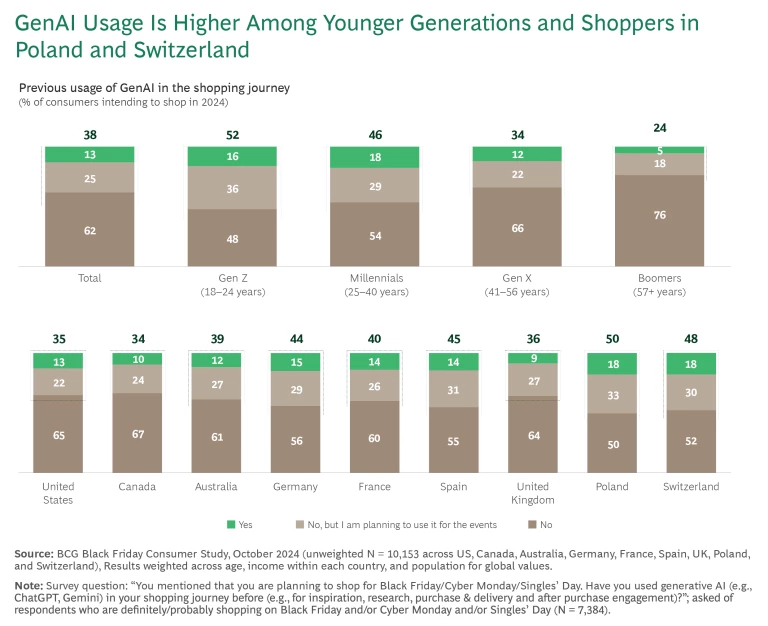Right now, up to 75% of consumers plan to capitalize on this year’s holiday sales events, and many will be using generative AI to help them find the best deals.
More than a third of consumers (38%) have already used GenAI in their shopping journey or are planning to use GenAI to shop during Black Friday, Cyber Monday, and Singles’ Day.
That’s according to a BCG survey that asked 10,000 consumers across nine countries in Europe, North America, and Australasia about their intentions and expectations ahead of holiday sales events.
The So What
“As inflation squeezes household budgets, GenAI is empowering consumers to make fast, informed decisions about what and where they buy,” says Jessica Distler, a BCG managing director and partner in Berlin who specializes in the retail industry.
“This Black Friday and beyond, consumers’ use of GenAI will push retailers to up their game.”

Survey respondents said their most common uses of GenAI are to:
- Find the best deals for specific items
- Research product information
- Compare different products
Some consumers also reported using GenAI to generate shopping lists and brainstorm gift ideas within their budgets.

The survey also suggests that increased use of GenAI to help purchase decisions is a trend that is likely to continue, with 80% saying they found it helpful, and nearly 40% saying they plan to use it more frequently in the future. This trend is even more pronounced among younger consumers.

Overall, consumers plan to spend a minimum of $310 during the sales events. With ongoing concerns about the cost of living, there is expected to be a spending increase across most countries surveyed as consumers target discounts.
But, as is usual for the holiday season, retailers will need to work hard to earn consumers’ attention in a crowded discount environment.
A fifth of consumers think there are ongoing promotions and discounts throughout the year, meaning they expect additional discounts during the sales events themselves. At the same time, consumers are easily able to track prices well ahead of time. Promotions that are meaningful and personalized will better speak to consumers and cut through the clutter.
“Retailers need to appreciate just how savvy consumers are these days. They start shopping early, and they want to see real, straightforward deals,” says Nate Shenck, BCG’s global head of retail.
“Brands that deliver clear value with a personalized touch are best positioned to win over consumers this holiday season.”
Now What
This is how retailers can position themselves for success before, during, and after the sales season:
Communicate clearly. Ensure clear and simple communication of deals to customers and aim to differentiate from competitors through discount levels, personalized messaging, or additional perks such as free shipping, early bird discounts, or exclusive loyalty benefits. It’s also important to create a sense of urgency by communicating prominently about time restricted deals.
Find the right mix of products and discounts. Consumers are on the lookout for essentials and gifts at steep discounts (30% or more). While consumers prefer blanket discounts of “x% across everything,” retailers need to balance an attractive offering for consumers with their own margins. To help achieve that in the long run, retailers can increase their own use of AI to find the optimal discount levels and best products to discount.
Double down on GenAI. GenAI solutions can be integrated into shopping experiences to help meet rising expectations for personalized and efficient shopping support, such as gifting assistants or virtual fitting rooms. It can also be used to drive traffic and increase conversion rates by ensuring the right people receive the right promotions at the right time. Retailers should also ensure visibility with algorithms to appear in GenAI outputs.
Download a copy of the survey here.
Local data is available upon request for Australia, Canada, Germany, France, Spain, Switzerland, Poland, UK, and US.




